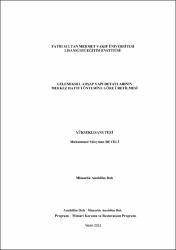| dc.contributor.advisor | Dabanlı, Ömer | |
| dc.contributor.author | Develi, Muhammed Süleyman | |
| dc.date.accessioned | 2019-08-02T07:56:46Z | |
| dc.date.available | 2019-08-02T07:56:46Z | |
| dc.date.issued | 2019 | |
| dc.identifier.citation | DEVELİ, Muhammed Süleyman, Geleneksel Ahşap Yapı Detaylarının Merkez Hattı Yöntemine Göre Üretilmesi, Fatih Sultan Mehmet Vakıf Üniversitesi Lisansüstü Eğitim Enstitüsü Mimarlık Anabilim Dalı, Yayımlanmamış Yüksek Lisans Tezi, 2019. | en_US |
| dc.identifier.uri | https://hdl.handle.net/11352/2890 | |
| dc.description.abstract | Merkez hattı yöntemi, geleneksel ahşap yapılardaki geçme detaylarının yüksek
hassasiyet ile üretilip yüklerin, taşıyıcı bileşenler arasında dengeli bir şekilde
dağılmasını ve ahşap yapının nizami olarak inşa edilmesini sağlayan bir imalat
yöntemidir. Gerek ahşap malzemenin özelliklerinden dolayı, gerekse işlem
zorluğundan dolayı kerestenin yüzeyi tam olarak düz olmayabilir. Düz olmayan
yüzeyden alınan ölçü, zıvananın kereste üzerinde yanlış konumlanmasına yol
açmakta, bu da geçmenin gerçekleşmemesine yol açmaktadır. Zira en küçük bir
engel dahi zıvanaların birbirine geçmesine mani olmaktadır. Bununla birlikte
zıvanaların birbirine uygun açılmaması taşıyıcı bileşenler arası yükün dengeli
dağılmamasına, bu da taşıyıcı sistemde zayıf noktalar oluşmasına yol açmaktadır.
Geleneksel inşaat bilgisinin bir tezahürü olarak merkez hattı yöntemi, bu sorunları
çözmektedir. Oluşturulan merkez hattı çizgisi, tüm taşıyıcı bileşenlerin imalatı için
referans oluşturmakta ve tüm bileşenler nizami bir bütün oluşturacak şekilde imal
edilemektedir.
Geleneksel ahşap yapı detaylarının merkez hattı yöntemine göre üretilmesini ele alan
bu çalışmanın giriş bölümünde, amaç, kapsam ifade edilmiş ve mevcut yayınlar
taranmıştır. İkinci kısmın ilk başlığında ahşabın biyolojik yapısına dair bilgiler
verildikten sonra mukavemet özellikleri incelenmiştir. Geleneksel ahşap taşıyıcı
sistemler başlığı altında, taşıyıcı bileşenler çalışma doğrultusuna göre gruplanarak
incelenmiş, zıvana ve geçmeler, taşıyıcı bileşenlerden ayrı olarak ele alınmıştır.
İkinci bölümün son başlığında geçmeler tiplere göre gruplandırılmış ve merkez hattı
yöntemi ile imalatına yönelik çizimler verilmiştir.
Üçüncü bölümde “merkez hattı yöntemi” detaylı olarak irdelenmiştir. Yöntemin
tarihi kökleri araştırıldıktan sonra hangi geleneksel aletlerin yöntem ile bütünleştiği
incelenmiştir.
İmalata dair detaylı anlatımlar dördüncü kısımda yer almaktadır. İmalat en başından
sonuna kadar örnek görseller ile adım adım açıklanmıştır. Bölümün sonunda tez
kapsamında bir adet örnek yapılmıştır.
Beşinci bölüm, merkez hattı yönteminin Anadolu’daki karşılığının aranmasına
ayrılmıştır. Anadolu’da bu yöntem ile inşa edilmiş dini ve sivil mimarlık örnekleri
araştırılmış ve yapılar, her iki grubun detayları korunmuşluk durumları farklı olduğu
için kamusal ve sivil ölçekli olarak ikiye ayrılarak incelenmiştir.
Son bölümde yöntemin avantaj ve dezavantajlarına dair sonuçlar ile yöntemin
Anadolu’daki izlerinin korunmasına dair öneriler sunulmuştur. | en_US |
| dc.description.abstract | The center line method is a manufacturing method that ensures the details of
joineries in traditional wooden structures which produced with high precision and
that the loads are distributed evenly between the structural components and that the
wooden structure is constructed properly. The surface of the timber may not be
completely flat, either due to the properties of the wood material or the difficulty of
processing. The measurement taken from the uneven surface leads to the
misalignment of the bush on the timber, which results in no insertion. This is because
even the smallest obstacle prevents the tenons from engaging. However, if the bushes
do not open properly, the load between the carrier components is not evenly
distributed, resulting in weak points in the carrier system.
The center line method as a manifestation of traditional construction knowledge
solves these problems. The centerline is a reference for the manufacture of all the
structural components.
In the introductory part of this study, which deals with the production of traditional
wooden building details according to the center line method, the purpose, scope and
expression of the existing publications have been searched. In the first chapter of the
second part, after giving information about the biological structure of wood, strength
properties were studied. In the chapter of traditional wooden structural systems, the
structural components were grouped according to the working direction, and studied
separately. In the last part of the second chapter, mortise and tenons are grouped
according to the their types and drawings for the production by center line method
are given.
Detailed explanations on manufacturing are given in the fourth chapter. Production is
explained step by step with sample visuals from the beginning till the end. At the end
of the chapter, a sample production is given.
In the last chapter, the results, advantages and disadvantages of the method and the
suggestions for protection of the traces in Anatolia such as centerline method are
presented. | en_US |
| dc.language.iso | tur | en_US |
| dc.publisher | Fatih Sultan Mehmet Vakıf Üniversitesi, Lisansüstü Eğitim Enstitüsü | en_US |
| dc.rights | info:eu-repo/semantics/openAccess | en_US |
| dc.subject | Merkez hattı yöntemi | en_US |
| dc.subject | Geleneksel | en_US |
| dc.subject | Ahşap | en_US |
| dc.subject | İskelet | en_US |
| dc.subject | Zıvana | en_US |
| dc.subject | Geçme | en_US |
| dc.subject | Center line method | en_US |
| dc.subject | Traditional | en_US |
| dc.subject | Timber frame | en_US |
| dc.subject | Mortise and tenon | en_US |
| dc.subject | Joinery | en_US |
| dc.title | Geleneksel Ahşap Yapı Detaylarının Merkez Hattı Yöntemine Göre Üretilmesi | en_US |
| dc.type | masterThesis | en_US |
| dc.contributor.department | FSM Vakıf Üniversitesi | en_US |
| dc.relation.publicationcategory | Tez | en_US |
| dc.contributor.institutionauthor | Develi, Muhammed Süleyman | |



















